#Virtual Virtuosity
Explore tagged Tumblr posts
Text
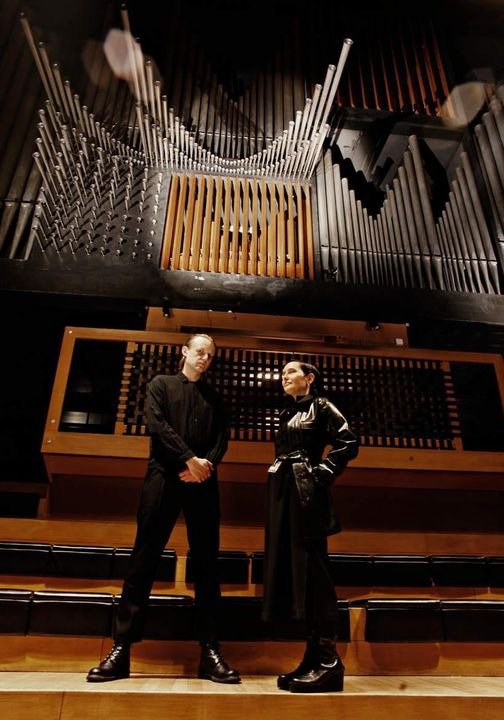
Dear Friends,
On November 29th-30th, the Aggregate, Electroacoustic Music Festival will take place in Berlin. This event merges tradition with electronic music, as through the use of MIDI, artists metaphorically awaken the spirit of the machine slumbering within the organ. Therefore, the festival features artists deeply connected to movements such as algorave—a type of event where the artist writes code in real-time, generating music—and electroacoustic traditions.
The festival’s approach to the relationship between musician and instrument is retro-futuristic, drawing from the ideas of electroacoustic avant-garde figures like Kotoński, Schaeffer, Varèse, Stockhausen, and many others. However, it raises new questions about how computer-controlled instrumental music, with its virtuosity, transcends the boundaries of perception in highly compressed musical events. It explores the intersections between electronic and acoustic music, objective interpretation, and the effects of mechanically precise performance.
Curators: gamut inc
Check the events: https://de.ra.co/events/1993705
#Electroacoustic#Music Festival#Berlin Events#Algorave#LiveCoding#MIDI#RetroFuturistic#AvantGarde Music#ElectroacousticTradition#Electronic Music#Organ Music#Sound Art#Virtual Virtuosity#Experimental Music#Music Technology#Aggregate Festival#GamutInc#RealTimeCoding#Musical Innovation#New Music#berlin
7 notes
·
View notes
Text
youtube
Virtuosity: The Most Underrated Sci-Fi Movie of the 90's? | Renegade Cut
This is the best remix video I have made yet, and I genuinely and lovingly hope that you enjoy it. Support Renegade Cut on Patreon: http://www.patreon.com/renegadecut
10 notes
·
View notes
Text




Virtuosity (1995)
#Virtuosity#scifi#virtual reality#retro futuristic#glitchy#scifiedit#filmedit#virtuosityedit#GIF#my gifs#Virtuosity Rewatch#Hide and Queue
50 notes
·
View notes
Text
Podcast #195: Hideaway (1995) & Brett Leonard's Virtual Worlds
Welcome to Episode #195 of The Swampflix Podcast. For this episode, Brandon, James, Hanna, and Britnee discuss the rudimentary CG realms of director Brett Leonard, starting with his supernatural serial killer thriller Hideaway (1995). 00:00 Welcome 01:58 Fools Rush In (1997)05:55 Jodorowsky’s Dune (2013)13:28 Rebecca (1940)16:13 Amateur (1994)20:40 Petals on the Wind (2014)25:33 We Were the…

View On WordPress
#brandon ledet#brett leonard#britnee lombas#computers#Hanna Räsänen#hideaway#james cohn#siegfried and roy#the lawnmower man#virtual reality#virtuosity
0 notes
Text
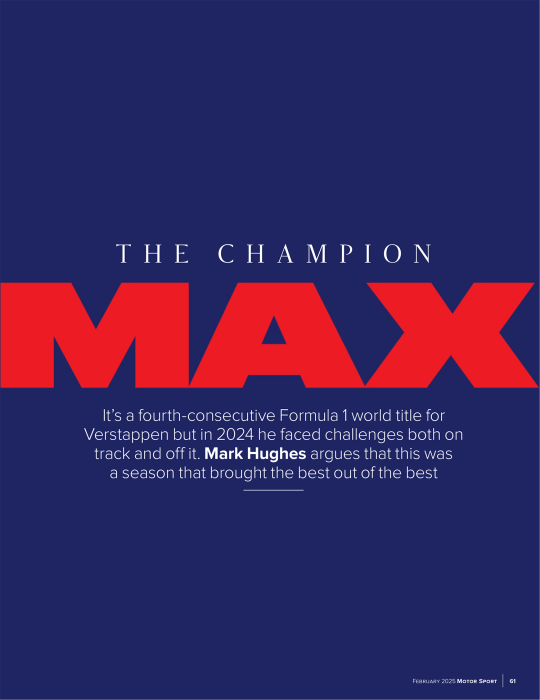
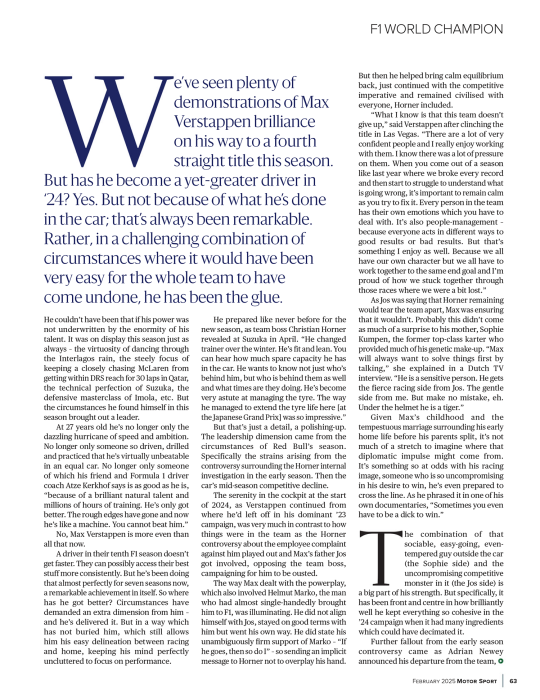
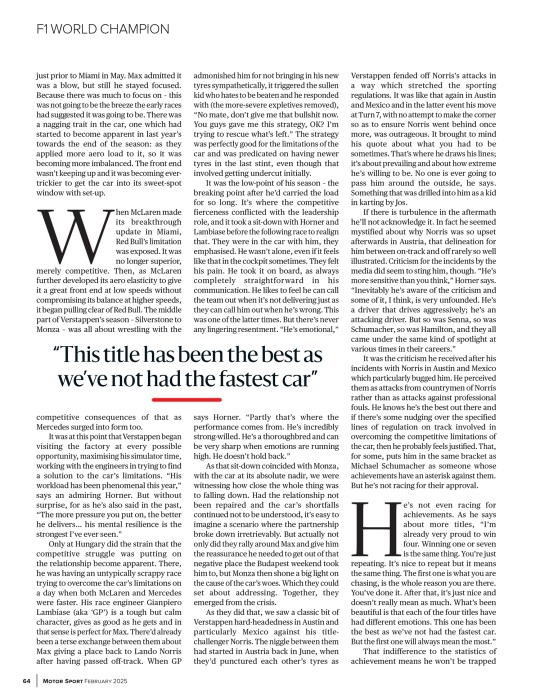

"A season that brought the best out of the best" Motorsport Magazine, February 2025 Issue, by Mark Hughes
We've seen plenty of demonstrations of Max Verstappen brilliance on his way to a fourth straight title this season. But has he become a yet-greater driver in '24? Yes. But not because of what he's done in the car; that's always been remarkable. Rather, in a challenging combination of circumstances where it would have been very easy for the whole team to have come undone, he has been the glue. He couldn't have been that if his power was not underwritten by the enormity of his talent. It was on display this season just as always – the virtuosity of dancing through the Interlagos rain, the steely focus of keeping a closely chasing McLaren from getting within DRS reach for 30 laps in Qatar, the technical perfection of Suzuka, the defensive masterclass of Imola, etc. But the circumstances he found himself in this season brought out a leader. At 27 years old he's no longer only the dazzling hurricane of speed and ambition. No longer only someone so driven, drilled and practiced that he’s virtually unbeatable in an equal car. No longer only someone of which his friend and Formula 1 driver coach Atze Kerkhof says is as good as he is, "because of a brilliant natural talent and millions of hours of training. He’s only got better. The rough edges have gone and now he’s like a machine. You cannot beat him." No, Max Verstappen is more even than all that now. A driver in their tenth F1 season doesn't get faster. They can possibly access their best stuff more consistently. But he's been doing that almost perfectly for seven seasons now, a remarkable achievement in itself. So where has he got better? Circumstances have demanded an extra dimension from him – and he's delivered it. But in a way which has not buried him, which still allows him his easy delineation between racing and home, keeping his mind perfectly uncluttered to focus on performance.
He prepared like never before for the new season, as team boss Christian Horner revealed at Suzuka in April. "He changed trainer over the winter. He's fit and lean. You can hear how much spare capacity he has in the car. He wants to know not just who's behind him, but who is behind them as well and what times are they doing. He's become very astute at managing the tyre. The way he managed to extend the tyre life here [at the Japanese Grand Prix] was so impressive."
But that's just a detail, a polishing-up. The leadership dimension came from the circumstances of Red Bull's season. Specifically the strains arising from the controversy surrounding the Horner internal investigation in the early season. Then the car's mid-season competitive decline.
The serenity in the cockpit at the start of 2024, as Verstappen continued from where he'd left off in his dominant '23 campaign, was very much in contrast to how things were in the team as the Horner controversy about the employee complaint against him played out and Max's father Jos got involved, opposing the team boss, campaigning for him to be ousted.
The way Max dealt with the powerplay, which also involved Helmut Marko, the man who had almost single-handedly brought him to F1, was illuminating. He did not align himself with Jos, stayed on good terms with him but went his own way. He did state his unambiguously firm support of Marko – "If he goes, then so do I" – so sending an implicit message to Horner not to overplay his hand.
But then he helped bring calm equilibrium back, just continued with the competitive imperative and remained civilised with everyone, Horner included.
"What I know is that this team doesn’t give up," said Verstappen after clinching the title in Las Vegas. "There are a lot of very confident people and I really enjoy working with them. I know there was a lot of pressure on them. When you come out of a season like last year where we broke every record and then start to struggle to understand what is going wrong, it's important to remain calm as you try to fix it. Every person in the team has their own emotions which you have to deal with. It's also people-management – because everyone acts in different ways to good results or bad results. But that's something I enjoy as well. Because we all have our own character but we all have to work together to the same end goal and I'm proud of how we stuck together through those races where we were a bit lost."
As Jos was saying that Horner remaining would tear the team apart, Max was ensuring that it wouldn't. Probably this didn't come as much of a surprise to his mother, Sophie Kumpen, the former top-class karter who provided much of his genetic make-up. "Max will always want to solve things first by talking," she explained in a Dutch TV interview. "He is a sensitive person. He gets the fierce racing side from Jos. The gentle side from me. But make no mistake, eh. Under the helmet he is a tiger."
Given Max's childhood and the tempestuous marriage surrounding his early home life before his parents split, it's not much of a stretch to imagine where that diplomatic impulse might come from. It's something so at odds with his racing image, someone who is so uncompromising in his desire to win, he's even prepared to cross the line. As he phrased it in one of his own documentaries, "Sometimes you even have to be a dick to win."
The combination of that sociable, easy-going, even tempered guy outside the car (the Sophie side) and the uncompromising competitive monster in it (the Jos side) is a big part of his strength. But specifically, it has been front and centre in how brilliantly well he kept everything so cohesive in the '24 campaign when it had many ingredients which could have decimated it.
Further fallout from the early season controversy came as Adrian Newey announced his departure from the team, just prior to Miami in May. Max admitted it was a blow, but still he stayed focused. Because there was much to focus on – this was not going to be the breeze the early races had suggested it was going to be. There was a nagging trait in the car, one which had started to become apparent in last year's towards the end of the season: as they applied more aero load to it, so it was becoming more imbalanced. The front end wasn’t keeping up and it was becoming ever trickier to get the car into its sweet-spot window with set-up.
When McLaren made its breakthrough update in Miami, Red Bull's limitation was exposed. It was no longer superior, merely competitive. Then, as McLaren further developed its aero elasticity to give it a great front end at low speeds without compromising its balance at higher speeds, it began pulling clear of Red Bull. The middle part of Verstappen’s season – Silverstone to Monza – was all about wrestling with the competitive consequences of that as Mercedes surged into form too.
It was at this point that Verstappen began visiting the factory at every possible opportunity, maximising his simulator time, working with the engineers in trying to find a solution to the car's limitations. "His workload has been phenomenal this year," says an admiring Horner. But without surprise, for as he’s also said in the past, "The more pressure you put on, the better he delivers… his mental resilience is the strongest I've ever seen."
Only at Hungary did the strain that the competitive struggle was putting on the relationship become apparent. There, he was having an untypically scrappy race trying to overcome the car’s limitations on a day when both McLaren and Mercedes were faster. His race engineer Gianpiero Lambiase (aka ‘GP’) is a tough but calm character, gives as good as he gets and in that sense is perfect for Max. There’d already been a terse exchange between them about Max giving a place back to Lando Norris after having passed off-track. When GP admonished him for not bringing in his new tyres sympathetically, it triggered the sullen kid who hates to be beaten and he responded with (the more-severe expletives removed), “No mate, don’t give me that bullshit now. You guys gave me this strategy, OK? I’m trying to rescue what’s left.” The strategy was perfectly good for the limitations of the car and was predicated on having newer tyres in the last stint, even though that involved getting undercut initially.
It was the low-point of his season – the breaking point after he’d carried the load for so long. It’s where the competitive fierceness conflicted with the leadership role, and it took a sit-down with Horner and Lambiase before the following race to realign that. They were in the car with him, they emphasised. He wasn’t alone, even if it feels like that in the cockpit sometimes. They felt his pain. He took it on board, as always completely straightforward in his communication. He likes to feel he can call the team out when it’s not delivering just as they can call him out when he’s wrong. This was one of the latter times. But there’s never any lingering resentment. “He’s emotional,” says Horner. “Partly that’s where the performance comes from. He’s incredibly strong-willed. He’s a thoroughbred and can be very sharp when emotions are running high. He doesn’t hold back.”
As that sit-down coincided with Monza, with the car at its absolute nadir, we were witnessing how close the whole thing was to falling down. Had the relationship not been repaired and the car’s shortfalls continued not to be understood, it’s easy to imagine a scenario where the partnership broke down irretrievably. But actually not only did they rally around Max and give him the reassurance he needed to get out of that negative place the Budapest weekend took him to, but Monza then shone a big light on the cause of the car’s woes. Which they could set about addressing. Together, they emerged from the crisis.
As they did that, we saw a classic bit of Verstappen hard-headedness in Austin and particularly Mexico against his title challenger Norris. The niggle between them had started in Austria back in June, when they’d punctured each other’s tyres as Verstappen fended off Norris’s attacks in a way which stretched the sporting regulations. It was like that again in Austin and Mexico and in the latter event his move at Turn 7, with no attempt to make the corner so as to ensure Norris went behind once more, was outrageous. It brought to mind his quote about what you had to be sometimes. That’s where he draws his lines; it’s about prevailing and about how extreme he’s willing to be. No one is ever going to pass him around the outside, he says. Something that was drilled into him as a kid in karting by Jos.
If there is turbulence in the aftermath he’ll not acknowledge it. In fact he seemed mystified about why Norris was so upset afterwards in Austria, that delineation for him between on-track and off rarely so well illustrated. Criticism for the incidents by the media did seem to sting him, though. “He’s more sensitive than you think,” Horner says. “Inevitably he’s aware of the criticism and some of it, I think, is very unfounded. He’s a driver that drives aggressively; he’s an attacking driver. But so was Senna, so was Schumacher, so was Hamilton, and they all came under the same kind of spotlight at various times in their careers.”
It was the criticism he received after his incidents with Norris in Austin and Mexico which particularly bugged him. He perceived them as attacks from countrymen of Norris rather than as attacks against professional fouls. He knows he’s the best out there and if there’s some nudging over the specified lines of regulation on track involved in overcoming the competitive limitations of the car, then he probably feels justified. That, for some, puts him in the same bracket as Michael Schumacher as someone whose achievements have an asterisk against them. But he’s not racing for their approval.
He’s not even racing for achievements. As he says about more titles, “I’m already very proud to win four. Winning one or seven is the same thing. You’re just repeating. It’s nice to repeat but it means the same thing. The first one is what you are chasing, is the whole reason you are there. You’ve done it. After that, it’s just nice and doesn’t really mean as much. What’s been beautiful is that each of the four titles have had different emotions. This one has been the best as we’ve not had the fastest car. But the first one will always mean the most.”
That indifference to the statistics of achievement means he won’t be trapped into chasing numbers that only mean anything to outsiders. But there’ll be a conflict between his love of racing and his stated yearning not to be racing long before he reaches 40 (which is what Lewis Hamilton used to say too!). That conflict will surely play a crucial part in what he decides to do with the rest of his life. He’s never known any other life, of course, as the boy brought up in the circus.
As a driver he’s one of the all-time greats, a more formidable all-rounder even than Fernando Alonso, faster, more extreme. But similar. Alonso is the nearest driver in overall traits. But even the great Alonso bows down to the level Max has attained. The number of times Max has not maximised his car since joining Red Bull in 2016 can be counted on the fingers of one hand. Is he the outright fastest over a lap? Often he is, yes. But this is a misunderstood concept. A driver can only get to the ceiling of his ability if the car’s traits, the way it is balanced, allow him to. There are many reasons why it won’t be, especially in this era of thermally sensitive tyres.
But let’s assume every driver on the grid was magically given a fully competitive car, each perfectly balanced to match the outer edge of their specific style, in how each driver was wired up physiologically. Would Max be the fastest in qualifying? Possibly not. If it wasn’t him, you’d be looking for Charles Leclerc, possibly Lewis Hamilton at the height of his powers. But in the grind of a race and the even grittier grind of a season, would Verstappen in those circumstances prevail? Almost certainly he would, yes.
There’s no weakness. Schumacher had weaknesses, Senna too. Alain Prost was as rounded as Max but not as quick. Before then, we are heavily into the dangerous era – the years which killed Gilles Villeneuve or Jochen Rindt or Jim Clark and mortally wounded Stirling Moss, drivers who, like Senna, could conjure things that left their contemporaries shaking their heads in wonder. None of the current stars, Max included, quite have that. But Max can maximise every situation with unerring consistency like Fangio, like Clark, like Stewart. And if the peaks of his raw speed are not quite as miraculous as some of the past, he runs close to that almost all of the time, probably more than anyone before.
He’ll be missed when he’s gone, when the rewards no longer offset the energy draining irritations.
269 notes
·
View notes
Text
movies need to stop describing themselves as “the chinese hamlet” “the korean hamlet” when they’re just revenge-centered period dramas with a court setting. you will NEVER be the tibetan hamlet, prince of the himalayas (2006), which takes virtually every line of dialogue directly from shakespeare’s play and yet manages to completely flip the narrative in a truly virtuosic display of adaptational prowess
123 notes
·
View notes
Text




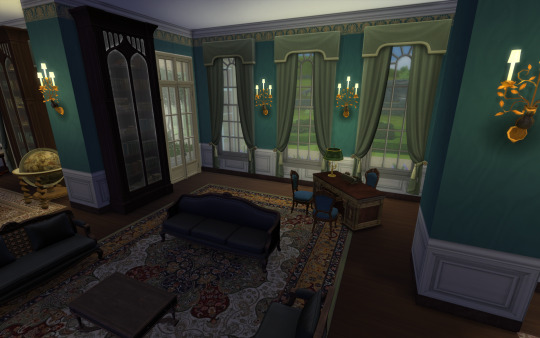




Prestwald Hall
Hi guys!!
I'm sharing Prestwald Hall . This is the 9th building for my English Manors Collection, and I will add many more!
House History: Prestwold Hall was, for many years, the seat of the Packe family. Before that time, it was the home of the Skipwith family. After the death of Major Robert Christopher Packe (born c.1783) - one time Aide-de-camp to King George III - who was killed during the Battle of Waterloo, the hall passed to his nephew George Hussey Packe who held the hall and estate until his death in 1874.
The Hall was remodelled by architect William Burn in 1842–1844, incorporating the fabric of a mid-18th-century H-plan house. It was Grade I listed in 1951.
One of the finest rooms inside the house is the Entrance Hall with its richly coloured marbled plaster work in the Italian style. The painted ceiling was inspired by Raphael’s Vatican grotesques and incorporates miniature landscapes, showing the house before and after its remodelling between 1842 and 1844. Below the ceiling, wreathing the room, are small medallion busts of the poets from Chaucer to Scott, positioned in the spandrels and are likely inspired by Alberti's external arcade at the Tempio Malatestiano in Rimini. An arcade opens on to a vaulted corridor leading to a top lit inner hall: these spaces also marbled. Off the corridor, the cantilevered stone staircase survives from the eighteenth century house, and was given its bracketed brass balusters by William Wilkins (1751-1815) in 1805.
The Dining Room, added by Wilkins in 1805, was incorporated into the remodelling undertaken by the Scottish architect William Burn in 1842. The room is overlooked by two dramatic full length portraits of Sir Edward Hussey Packe, KBE (1878 – 1946) and the Hon. Lady Mary Sydney Packe (née Colebrooke, 1890 – 1973) by the painter Glyn Philpot RA (1844 – 1947). The portrait of Lady Packe, painted in 1911, was described by the art historian Robin Gibson OBE as an ‘amazing feat of virtuosity’. Its elongated elegance and introspective characterisation is totally without the fashion-plate vulgarity of much Edwardian portraiture. Other portraits hang in this room of the Packe family including a painting of Sir Christopher Packe (1595 – 1682) who purchased the house in the 17th century painted by Cornelis Janssens van Ceulen (1593 –1661).
The library extends nearly the entire length of the house when the large doors that separate it from the drawing room are opened, connecting the two rooms. With clever use of constructional steel, William Burn was able to create these long adjoining rooms. The windows rise from floor level and open onto the garden which enhances the notion that Prestwold was designed in the style of an Italian classical villa. The doors and bookcases in library were made for George Hussey Packe (1846–1908) by Gillows of Lancaster and London in 1875.
A conservatory fills the recessed central bay at the front of the house, and projects out towards the garden. Behind the glass and elegant Doric pilasters, are well planted raised beds with a number of exotic plants and flowers
More history: https://en.wikipedia.org/wiki/Prestwold_Hall
Virtual tour: https://www.prestwold-hall.com/virtual-tour/

Night pics



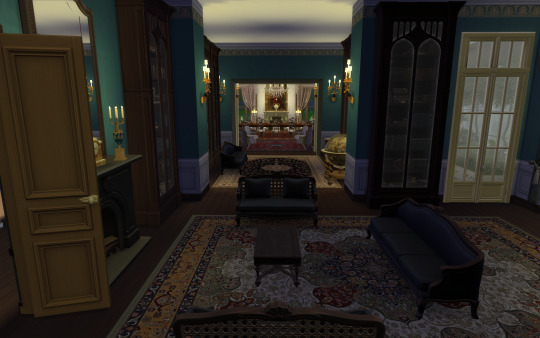

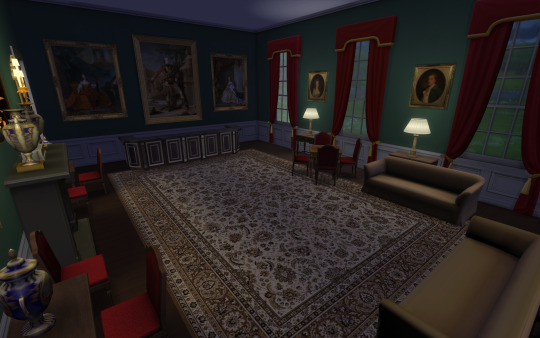


Floorplans




This house fits a 50x40 lot and features the following:
great hall
long Library
formal dinning room
family room
playroom
formal gallery
a winter garden
14 rooms for family/guests + 3 service rooms
several bathrooms
This time I decorated most of the rooms in the main floor for picture purposes, but as allways, you can make it your own!
The second and third floor (bedrooms) are not decorated, but finished.
Hope you like it.
You will need the usual CC I use:
all Felixandre cc
all The Jim,
SYB
Anachrosims
Regal Sims
King Falcon railing
The Golden Sanctuary
Cliffou
Dndr recolors
Harrie cc
Tuds
Lili's palace cc
Please enjoy, comment if you like it and share pictures with me if you use my creations!
Early Access: August 15
Download: https://www.patreon.com/posts/prestwald-hall-104505183
#sims 4 architecture#sims 4 build#sims4#sims 4 screenshots#sims4play#sims 4 historical#sims4building#sims4palace#sims 4 royalty#ts4 download#sims4frencharchitecture#ts4#ts4 gameplay#ts4 simblr#ts4 legacy#ts4cc#the sims community#the sims 4#sims 4
38 notes
·
View notes
Text
youtube
Song Review: Tommy Emmanuel - “Jolly Swagman” (Live)
It’s no surprise Tommy Emmanuel can make a single acoustic guitar sound like a band. But it’s pretty shocking he can also coax sounds reminiscent of bagpipes from the six-stringer.
Yet, that’s precisely what Emmanuel does at the tail end of “Jolly Swagman,” the lead single from the forthcoming (March 21, 2025) Live at the Sydney Opera House. The tune doesn’t breach the three-minute mark, but Emmanuel fills the 170 seconds that are there with peerless virtuosity; multiple layers of rapid-fire, instrumental exuberance set off with sonic ellipses of calmness before the phantom bagpipes conjure a misty Scottish scene on stage Down Under.
The audience, of course, goes bonkers, as virtually everyone does - except those stunned into disbelieving silence - when Emmanuel plays.
Grade card: Tommy Emmanuel - “Jolly Swagman” (Live) - A+
12/9/24
7 notes
·
View notes
Text
RAIDER OF THE LOST ARTS
Jeff Buckley Revisited
by Simeon FlickMarch 2023
Remember me, but oh, forget my fate. ––Henry Purcell, “Dido’s Lament”
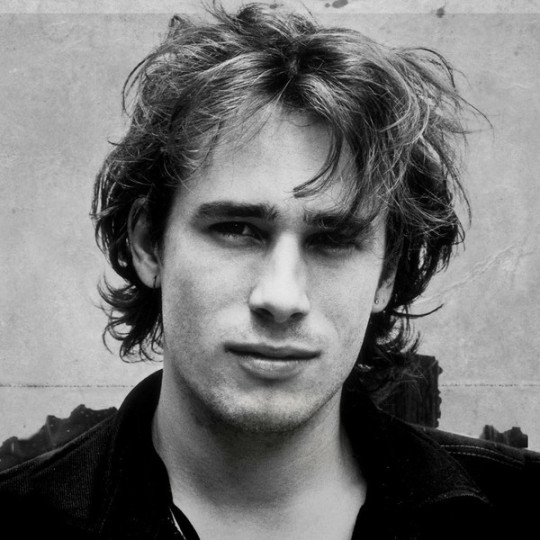
Jeff Buckley
When Jeff Buckley drowned in the Wolf River tributary of the Mississippi on May 29, 1997, just as his band was arriving at the Memphis airport to start helping him finally nail down the long-awaited and already agonized-over second album, music lost not only one of its most singular and revolutionary of raw talents, but also the most mythologized—even during his lifetime—since Kurt Cobain’s death just three years prior. Buckley bore the boon and bane of being the scion of an also semi-famous and ill-fated folk/jazz/soul singer named Tim, and spent his entire life and career—following a single week-long reunion just before Tim’s 1975 death from an accidental heroin overdose—futilely trying to distance himself from the wayward father he never knew apart from the music of nine mostly half-baked studio albums. That an ever-growing number of people, the majority having discovered Jeff’s music post-mortem, feel they know the son better than he or anyone else knew his father, and still feel his loss as acutely as one would a dear family member, is a testament to the unparalleled emotional conveyance and lasting legacy of Jeff’s music despite having released only one official studio album during his lifetime (1994’s hauntingly gorgeous, seamlessly diverse Grace, which has found a home on innumerable “Greatest” lists and has been declared a personal favorite by many of his idols). Jeff Buckley’s influence lives on in the burgeoning underground cult of posthumous acolytes, and in the hyper-emotive, falsetto- and vibrato-laden, multi-octave vocal histrionics of so many subsequent singers, which only seem to come off as pale and obvious allusions that smack more of imitation than assimilation, much less embodiment, and we may never see his like again.
**************
Jeff Buckley entered the world during a meteor shower on the evening of November 17, 1966, the son of an already absent father and a mother, Mary Guibert, who at 18 wasn’t much more than a child herself. Like Cobain, who would arrive only three months later, Jeff had a typical Gen X childhood, replete with divorce, paternal estrangement and maternal domination, often violently reinforced alienation from his formative peers and unstable itinerancy (Mary dragged him through virtually every backwater town in California for all too short stints before he finally put his foot down in Anaheim, where both parents had grown up, and where extended family awaited). The sole refuge, besides the brief but stabilizing presence of the occasional father figure like stepdad Ron Moorhead, was the music men like him turned Jeff onto: Led Zeppelin, Joni Mitchell, Bob Dylan, and countless others who would seemingly become part of his DNA. Music became his north star, his raison d’être, and when things went wrong, which was all too often (Jeff had to be a rock for flighty mother Mary, taking on too many of her responsibilities too young), he would escape into it for hours.
This would compound once he took up the guitar. Like many children of musicians do, in order to carve out a distinct musical identity (and to maintain a healthy generation gap), Jeff—or Scotty, as he was known by his middle name then––gravitated towards Gen-X’s chosen instrument: the electric guitar, to the exclusion of his mother’s classical piano and his father’s acoustic guitar and vocalizations. Aside from the occasional lead vocal in a high school cover band, mostly for the high-ranged prog-rock and new wave classics none of his other bandmates could pull off, he considered himself just a guitar player in the ’80s. But not just any player; with Al DiMeola as one of many paragons, Jeff threw himself headlong into the world of virtuosic technique, teaching himself complicated licks by ear as he worked diligently to master not just the instrument but music itself.
This trajectory was maintained after his 1984 high school graduation with a stint at the derided Los Angeles organization, MIT (Musician’s Institute of Technology), with its many specialized subsidiaries, including GIT (Guitar Institute of Technology), where Jeff continued his musical edification. After obtaining his virtually useless professional certificate from GIT but with his gun-slinging reputation solidified a year later, he gigged in various area bands and worked as a studio rat, arranging and recording demos for other aspiring artists. But the lead vocalist in him remained as of yet dormant.

Jeff’s father, Tim Buckley.
By the late ’80s it was already soul-crushingly evident that Los Angeles was a dead-end cesspool of intolerable immersion in other people’s music, and that a drastic change was required to sweep away the bad influences and external white noise to finally get him in touch with his own muse. New York City beckoned—just as it had to Tim in the ’60s—as a locus were people could become the epitome of themselves, get as weird as they wanted, and be unconditionally accepted or ignored as merely part of the scenery, and reach their full, rewarded potential in whatever their chosen field. Jeff tested the waters for a few months in 1990, but his money and options ran out, and he reluctantly returned to Los Angeles.
It wasn’t until April 26, 1991, when he performed as part of the Hal Willner-curated Greetings from Tim Buckley tribute show at Brooklyn’s St. Ann’s Church that he was able to lay the groundwork for a permanent relocation, having garnered the interest of several music industry types offering tangible professional succor, not to mention his first real girlfriend. That night marked the beginning of Jeff’s mythology-building not only as an artist in his own right, but also as an inextricable extension of his father’s legacy; many of the concert’s attendees were blown away not just by Jeff’s supposedly similar voice and delivery, but also by his physical resemblance (apparently there were some eerie backlit cheekbone shadows cast against the church hall walls that heightened the drama).
That there was so much defensiveness and/or mandated avoidance in so many subsequent interviews seems very bite-the-hand-that-feeds, but everyone has to break free from their parents at some point; that it often requires the assistance of those selfsame parents is a frustratingly ironic aspect of adulthood most of us have to face and embrace. Jeff simply had the misfortune of doing it in a highly scrutinized industry with zero—or even negative—expectations or tolerance of rock star progeny. He was also not only abandoned by his father, to whose funeral he was not even invited, but also projected on by Tim-obsessed fans and former love interests expecting the son to deliver on the father’s failed promise(s).
Jeff set up shop, and with the assistance of a demo tape of original songs he had recorded while still languishing in Los Angeles (courtesy of father Tim’s old manager, Herb Cohen), and a threadbare press kit (the only news clipping being a photocopied review of the Tim memorial show), he began beating the Manhattan pavement to drum up gigs and busk on the streets.
As of yet, short on original material, he leaned on sophisticated covers that resonated with his emphatically empathic and emotive spirit as he wall-pasta’d in search of a unique artistic identity. Songs by more recently assimilated influences like Nina Simone, Edith Piaf, and Leonard Cohen stood side by side with pitch-perfect deep-cut gems by Van Morrison and the beloved Zeppelin, with all-inclusive guitar arrangements that cast his different-every-time performances in full-blown Technicolor. His self-accompaniment on electric guitar as opposed to the acoustic form usually favored by the often excessively earnest—if not outright cheesy—solo folk artists of the past (including early-phase Tim), differentiated him from obsolete traditions, and it also broadcast the implicit message that this lone performer would eventually have a band behind him.
But the comprehensive guitar skill was just a tripod for the potent weapon his voice was becoming.
It’s difficult for most laypeople to differentiate between learned technique and natural timbre. Jeff didn’t inherit his father’s vocal gift; his was high-ranged and effeminate instead, with a thick palate and some huskiness occasionally muddying up his tone production. But what he did with it despite or because of the confines of those “limitations” is absolutely astounding. Instead of self-consciously diluting his delivery, he threw the book at it, almost as a diversionary tactic, like a magician smoke-and-mirror distracting his audience from an otherwise debunkable prestige move. With his uncanny imitative abilities and concomitant penchant for self-pedagogy, he adopted a rapid vibrato in accordance with essential influences (Simone, Piaf, Garland, and even father Tim, as was his undeniable birthright), nicked tricky classical and R&B trills and phrasing, turned his angelic upper register into a strength by frequently, often breathily leaning into his falsetto, incorporated various operatic (chromatic glissandos) and jazz (scatting) effects, learned how to push a full chest voice into his higher register like Robert Plant (and Tim) and to raggedly scream like Cobain and others of his generation. He ran sustain drills as he traveled across the city in cabs or on foot, drawing out his notes as long as possible to hone his deftly rationed breath support (just try holding out along with the 25-second E4 at the end of Grace’s “Hallelujah”). Tim had set the bar high for the younger Buckley, and Jeff rose mightily to the challenge, developing a comprehensive technique that kept pace with his guitar mastery, which had been pared down to unassailable jazz progressions and Hendrixian blues tropes and, like Cobain, would feature downplayed––if any––solos for the duration. If Jeff’s musical continuo was a haunted house, his voice had become the ghost that lingered within it.
(There’s something more compelling about the resulting output of singer/songwriters who start out exclusively as instrumentalists; it makes for more effective and meaningful musical accompaniment and better structured songs, and they tend to work more diligently and eruditely at mastering vocal technique. Tim leaned almost exclusively on his phenomenal voice, and insufficient thought was given to structure and harmony in his songs, and the lyrics were by turns predominantly unremarkable or unwieldy, the main drawback of being able to sing the phonebook. The resulting chord changes and accompaniment were more limited, derivative, yet ironically more obtrusive. Jeff had harnessed hooks, vivid and compelling lyrical imagery, and upper harmony into underlying works that left room for everything important, but especially the vocals. Thus, Jeff managed to achieve with one album what Tim failed to do in nine; he produced a timeless classic.)
Jeff’s most crucial influence––his self-declared Elvis––was the Qawwali singer Nusrat Fateh Ali Khan. Qawwali singing introduced Jeff not only to its mystical eastern harmony, which was a subtle but unmistakable undercurrent in his guitar parts and his music in general, but also to a highly freeing ilk of vocal improvisation he would use to sparing but profound effect in his live performances, most notably in his wordless vocal warm-ups for things like “Mojo Pin” and “Dream Brother,” and in the way he would subtly tweak the songs’ melodies from show to show.
With all of this gelling within and beginning to burst out of him, Jeff flogged his wares at many a Manhattan venue, but he would find his symbiotic Shangri La at Sin-é, a hole-in-the-wall café run by a fellow man of Irish descent, ex-pat Shane Doyle. Jeff crystalized into the self-accompanying male diva he had been striving to become there at Sin-é and found a home away from home not only on the small stage, where he reveled in an unparalleled, as-of-yet anonymous freedom within the material, but also behind the counter, where he could often be found washing dishes.
This is where Jeff’s buzz began to build, thanks to his Monday night residency, the impression he had made on the industry folk at Tim’s memorial concert (including several Columbia employees who started showing up on the regular), and the steadily growing crowds comprised predominantly of young women. As word of mouth spread and audiences began to overflow onto the sidewalk, the higher-ups at several major labels started circling to investigate the fresh blood in the water. A hilarious bidding war ensued, with record company execs actually trying to make table reservations at the tiny walk-in café, and the street’s curbs clogging with limousines. Jeff would end up signing with Columbia, a Sony subsidiary that was home to many of his heroes, and that made all the right overtures and promises to this hot young talent who was desperately intent on accomplishing the impossible feat of using and defeating the music industry from the inside, as opposed to being consumed by it like his father had been.
**************
Jeff’s “million dollar” deal––consisting of a $100,000 advance, a higher than normal royalty rate, and a three-album guarantee––was unusual for a solo artist of that time, considering there were scant few original songs, no band, and no official demo tape to speak of (the L.A. recordings, which Jeff in his humorously nihilistic cups had dubbed The Babylon Dungeon Sessions, technically fulfilled the applicable criteria but weren’t aurally suitable). Columbia knew they had a hot property on their hands, the Gen-X manifestation of a Dylan or Springsteen-esque heritage artist, and Jeff made sure they knew, mostly through intentional late arrivals to countless business meetings. But because his talents spanned so deep and wide, everyone was initially at a loss as to what form his recorded output should take. What the hell do you do with an artist that has the chops and versatility to go in any direction??
The logical first step was to try and capture the solo version of Jeff on tape and issue it as a soft introduction. Live At Sin-é was culled from two performances recorded during the summer of 1993 and released on November 23 as a perfunctory, slightly disappointing four-song EP consisting of two originals (“Mojo Pin,” and “Eternal Life,” both of which would get definitive, full-band versions on Grace), and two covers (a rhapsodically incendiary rendition of Van Morrison’s “The Way Young Lovers Do” and a transcendent reading of Edith Piaf’s “Je N’en Connais Pas La Fin,” complete with a fingerpicked merry-go-round guitar waltz for the French-sung refrain).
In Columbia’s posthumous ambition to exploit remaining vault caches to continue paying down Jeff’s sizable debt to the label, the original release’s felonious dearth was rectified with 2003’s Legacy Edition, a two-disc, one DVD set that was a much more complete representation of Jeff not just as an artist during that pre-fame period, but as a person. Along with scads more songs from the same shows, the expanded set includes between-song banter that manages to do what his scant, more visceral studio work couldn’t: put his pronouncedly nerdy, madcap, sometimes salacious sense of humor on full display.
Meanwhile, Jeff had also begun working toward his only completed studio LP. Sony had brought him in to record the lion’s share of his repertoire in February of ’93 as a way to gently kick off the A&R cataloguing and selection process for the album (these were later released as part of the 2016 compilation You And I), and recording sessions were scheduled for September at Bearsville Studios, which was located near Woodstock in upstate New York. The only problem––and it was a big one––was that he didn’t have a band. Like so many other aspects of Jeff’s career, this got rectified at the last possible moment; he met and connected with bassist Mick Grondahl first, then drummer Matt Johnson less than a month out from the initial recording dates.
A tall, dark, and handsome Dane, Grondahl had an ideal combination of low-key receptiveness and musical adventurousness that allowed him to be the perfect on- and offstage wingman: he was interesting in an unobtrusive way. Johnson was a wet-eared Texan who had the ideal balance of power and precision (a slight and diminutive presence, Johnson’s physicality was bolstered by his construction day job) and the breadth of taste and experience to match the extreme dynamic variations of Jeff’s sonic palette (Johnson could crush it like Bonzo or play pindrop-soft like a seasoned jazz pro––whatever the music required).
Columbia was less than pleased that Jeff had recruited a rhythm section with virtually no stage or studio experience, but he would eventually be proven right in his selection of introverted, lump-of-clay rookies that doubled as a gang of friends who could hang with him in every sense, especially through all the spontaneous twists and turns he threw at them. This was one of many battles he would actually win for the better against Sony, though he would initially come off as the loser (it took a few months for the band to get up to speed on the Grace repertoire, because they rarely if ever played the album’s songs during rehearsals or soundchecks, preferring to fill that time with “jamming,” since they needed to build an intuitive rapport. They also knew they would be playing the same emotionally demanding songs night after night for the next year or two).
The trio began work on Grace at Bearsville Studios, which had been pre-rigged with several different recording environments to spontaneously capture whatever came out of Jeff and his band in any permutation and style, whether it was solo, low-key jazz combo or full-on rock group. Andy Wallace, who had dialed in the mixes for Nirvana’s Nevermind, wore the coproducing and engineering hats for these sessions, along with providing a regimented lens through which to focus and refract Jeff’s chaotic genius. Recording proceeded slowly and steadily, without too much fanfare, but then, again at the last minute there was an explosion of prodigious productivity. Among other developments, German vibraphone prodigy Karl Berger was in town, and with the assistance of a local quartet, he and Jeff co-arranged string parts for “Grace,” “Last Goodbye,” and “Eternal Life.”
The eleventh-hour burst of creativity suddenly began transforming Jeff’s modest debut into something more akin to the fully produced masterpiece that usually doesn’t happen until later in a discography. More studio time was booked for intensive overdubbing of additional layers, which pushed costs beyond the initial budget, and though Columbia held Jeff in high esteem and generally handled him with kid gloves (full artistic control was implicit), the majority of expenses went into his recoupable fund, which had to be paid down by Jeff through album sale royalties. Though Grace would eventually prove itself beyond worthy of the investment, this was one of the first major manifestations of Jeff’s Sony-sourced headache that would plague him for the duration.
Grace, which was finally released on August 23, 1994, tends to vex the neophyte at first blush. There’s so much to unpack, the resulting bottleneck can be off-putting. Only through repeated listens will it reward those who “wait in the fire,” as the title track has it. Once that rote assimilation has inured you to Jeff’s eccentric voice and anachronistically innovative affectations, and Grace has dilated your emotional receptivity wider than you ever thought possible, you will tend to listen obsessively for a while before you realize you need to take a break so your strung-out, wrung-out heart can snap back to normal. You will probably only be able to listen to it every once in a while thereafter, as the lachrymose music makes demands of your psyche that require exceptional equanimity to withstand (the irony is that while Grace might help you grieve a breakup or death, listening to its ten tracks can also exhume that grief long past the time you have worked through it). The fact that Jeff is no longer here but still sounds undeniably alive in the speakers, and that the making of this album led to insurmountable expectations for a satisfactory follow-up that added to his pre-death stress, only augments the album’s haunting intensity.
The sonic progeny of Robert Johnson, Nina Simone, Edgar Allan Poe, and John Dowland, Jeff comes off as the wide-amplitude, tragic-romantic, card-carrying Scorpio that he was, irresistibly obsessed with love and death, singing often of the moon and rain (and yet also of burning and fire), and bedroom-as-sanctuary-and-wellspring, and a melancholic, nearly heart-rending yearning for absent lovers past and present. All of this can’t help but feed into his steadily growing mythology, not to mention strike he’s-all-alone-and-vulnerable-go-save-him reverberations of longing through the heartstrings of every heterosexual female within earshot, while also getting straight men of all walks gratefully as in touch with their feminine side as he was. In the age of grunge––which force-fed emotion through intimidating volume and distortion––Grace was an anomaly, delivering a wider range of feeling through a listener’s induced surrender to its heightened peaks and valleys, with Jeff’s by turns angelic and demonic voice keeping pace, and, unlike Cobain, with absolutely no irony to lean on, hide behind, or use as disclaimer.
“Mojo Pin” is the perfect overture for an audiophile quality album with such wide yet still somehow cohesive style and dynamic oscillations, with softly looping guitar harmonics fading in, followed by a wordless melody delicately sung over a fingerpicked folk/jazz guitar pattern. The music rollercoasters from there, with dramatic stops featuring vocal melismas that proceed into straight 4/4 time, finally crescendoing in a loud, climactic buildup, and a ragged scream from Jeff that tapers seamlessly back into the jazz feel.
The first stanzas tell us so much about the author:
I’m lying in my bed, the blanket is warm This body will never be safe from harm Still feel your hair, black ribbons of coal Touch my skin to keep me whole
Oh, if only you’d come back to me If you laid at my side I wouldn’t need no mojo pin To keep me satisfied
Here we find a vividly lovelorn artist who tends to compose from the subconscious (as with many of his original songs, “Mojo Pin” was inspired by a dream he had had) has already begun confronting his mortality, equates love with addiction like so many troubadours before him (“mojo pin” is a euphemism for a shot of heroin, which, inspired in part by his father, Jeff used for a short time during the tour in support of Grace), and feels hopelessly separated from it all, with a heightened sense of longing that can’t help but garner the listener’s sympathies.
The title track picks up the thread in more ways than one; along with “Mojo Pin” it is the second of two pre-Sony songwriting collaborations with former Captain Beefheart guitarist Gary Lucas—as part of his short-lived Gods and Monsters project (that’s Lucas’s guitar-noodle wizardry on both). And with lines like “Oh, drink a bit of wine––we both might go tomorrow,” it ups the mortality-as-enabler-and-aphrodisiac ante.
With its churning 6/8 groove, and with Jeff starting the song in typical fashion––toward the bottom of his discernable vocal range (D3), “Grace” culminates cathartically on a sustained, heavily vibrato’d, full-chest E5 bad-assedly blasting from his manic larynx and also marks the first of several ominous allusions to being harmed by water (“…And I feel them drown my name…”).
“Last Goodbye” was supposed to be the big first single. It even got an MTV video treatment (just look at his dour expression as he and the exhausted band take a precious day off from a European tour to do this exorbitantly expensive production of a compromised artistic concept in a despised medium), but with no real chorus to speak of, its chart success was modest at best. A Delta blues slide glides across an open-tuned electric 12-string guitar before dropping into a mid-tempo dance groove and a lyric full of bittersweet memories of a failed relationship with an older woman in L.A.
Not only was Jeff a bit shorthanded when it came to filling an entire 52-minute album with originals, but it also would have been a shame not to round out the running order with some well-chosen and interpreted covers in emulation of the intimate immediacy of Jeff’s Sin-é days. The first of these appearing on Grace is “Lilac Wine,” a torch-song standard written by James Shelton and adopted by Nina Simone. Jeff gives the distant-lover-as-intoxicant lyrics the hyper-emotive treatment, with perfectly sustained vibrato on the drawn-out notes and with his voice occasionally breaking into a heartrending sob, especially on the line, “…Isn’t that she, or am I just going crazy, dear?”
“Lilac Wine” is a significant indication of the barely fathomable depth of Jeff’s––and by extension, the band’s––versatility and their ability to do exactly right by the artist and repertoire (it’s difficult, in that sense, to listen to any of Tim’s records without taking umbrage with the musicians in the various band incarnations smothering Tim’s voice and stepping all over his 12-string guitar with their ego-fulfilling and poorly––if at all––thought-out parts).
“So Real” represents not only the successful search for a second guitarist, but also a tenacious battle fought and won against Columbia for the very soul of the album.
Michael Tighe, a mutual friend of Jeff and his ex Rebecca Moore (the one he had met and fallen in love with at the Tim tribute, and whom “Grace”s lyrics supposedly feature) joined the band on second guitar after most of the work on the album had been completed, and he brought an intriguing set of chord changes with him. When it came time to record B-sides and possible non-album singles (a cover of Big Star’s “Kangaroo”, which, to Sony’s consternation would often stretch out to 15 or 20 minutes in concert, was also laid down), Tighe’s progressions, which were inordinately sophisticated considering he hadn’t been playing guitar for very long, were dusted off, tracked with engineer Cliff Norrell, and Jeff did the lead vocal in one take after a last-minute walk to finish the lyric.
Distinguished by the verses’ seamless changes in meter (back and forth from duple to triple time), its by-now standard mélange of tragic-romantic imagery in the lyrics (“I love you / But I’m afraid to love you,” and the foreboding “And I couldn’t awake from the nightmare that sucked me in and pulled me under…”), another wildly climactic E5 at the end, and a massive chorus hook, the song fit Jeff’s MO––accessible innovation and wide-amplitude expression––perfectly.
So much so that it quickly shed its B-side status and usurped a coveted spot on the record from another, highly contested original: The excessively personal and harsh “Forget Her,” which in retrospect would have been the sole manifestation of irony on the album. Jeff was justifiably dissatisfied with this disingenuously caustic 12/8 blues-pop dirge waltz he had allegedly penned about the aforementioned, hapless Moore, upon whom the lyric displaced Jeff’s own culpability for the relationship’s dissolution. But the label was head over heels with it, as the song’s melodramatic, Michael Bolton-esque chorus made it the one and only potential crossover smash in their minds. Columbia exec Don Ienner, who was essentially Jeff’s boss, tried everything short of bribery to futilely sweet-talk Jeff into keeping it on the album, which, in itself, was a tangible reason for Jeff to dig in, though he also feared that the slightly smarmy song would be a one-way ticket to One-Hit-Wonder-ville. As it turned out, “So Real”s chorus was hookier anyway, enough to warrant its own video treatment, though its subsequent commercial impact was also negligible.
A plaintive sigh kicks off what is now widely regarded as the definitive recording of Leonard Cohen’s “Hallelujah,” the second cover of the album, performed solo and glued together from multiple takes into a solemn paean to the ecstatic pain of long-term relationships. Inspired by John Cale’s 1991 reading, Jeff sticks to the ultra-romantic verses that find love and suffering linked in paradox, and the guitar tone and reverb augment the song’s church hymn vibe, almost as though it was recorded at a service or funeral. If you’ve heard this recording or noticed it in myriad movies and TV shows and haven’t cried at least once, you’re not human.
“Lover, You Should Have Come Over” is a classic swinging blues adagio, perhaps the best known and most covered original on the album. Water and death are linked once again (“Looking out the door, I see the rain fall upon the funeral mourners / Parading in a wake of sad relations as their shoes fill up with water…”), and then Jeff abruptly breaks that train of thought to do right by Moore in recognizing his role in their breakup (“…Maybe I’m too young / To keep good love from going wrong”). Again, his vocal starts low and builds to another E5 at the end. In the hands of another artist, all of this would have sounded forced and over the top, but somehow Jeff was able to make it work. That’s his genius/madness; he himself was fully dilated and committed in a way that wasn’t healthy or sustainable, but damn, did it make for visceral listening.
“Corpus Christi Carol” reaches even further back than 1950’s “Lilac Wine” and completely blows the listener away with its expectation-defying display of musical depth. He becomes a bona fide classical singer here, exhibiting total immersion in the anonymous 16th-century lyric that the aptly named English composer Benjamin Britten incorporated into 1933’s Choral Variations for Mixed Voices (“A Boy Was Born”), Op. 3, finally arriving at Jeff’s adolescent ears through the version for high voice recorded by Janet Baker in 1967. Jeff completely inhabits the allegory of a bedridden, Christ-like knight endlessly bleeding, witnessed by love and the purity of his cause, with the empathic delicacy that was already his trademark. The stark arrangement for electric guitar and scant overdubs is superbly matched by the lamenting vocal, which ends on a ghostly, falsetto’d E5 that is utterly cathartic in its climactic glory.
Jeff wanted to make an album that compelled rock fans to forget about Zeppelin II, and “Eternal Life” delivers on the heavier side of that promise. Written during his time in L.A., the creepy intro stops on a dime before a bludgeoning, yet highly danceable groove drops in and a reactive lyric confronts applicable listeners to wake up and smell the mortal coffee:
Eternal life is now on my trail Got my red-glitter coffin, man––just need one last nail While all these ugly gentlemen play out their foolish games There’s a flaming red horizon that screams our names…
Racist everyman, what have you done? Man, you made a killer of your unborn son Oh, crown my fear your king at the point of a gun All I want to do is love everyone…
There’s no time for hatred––only questions What is love, where is happiness What is alive, where is peace? When will I find the strength to bring me release?
With distorted bass as well as guitar alongside complementary strings and a killer groove featuring a highly effective, accelerating hi-hat pattern from Johnson on the verses, the song successfully proselytizes for universally incontestable causes, and reinforces Jeff’s projected mythology as a doomed soul whose seemingly relished fate awaits him sooner rather than later.
“Dream Brother” may be the last song on the album, but it was the very first idea Jeff and the band had worked up together. At the risk of overusing the word, and just like the album as a whole, it is haunting from start to finish, with a droney, string-cranking intro giving way to an eastern-inflected guitar motif. Jeff’s more static but no less sublime vocal melody goes beyond complementary; it builds tension by hanging on or around the fifth for most of the verse stanzas before resolving to the tonic on the last note of the phrase. Grondahl’s bass line, as with all his work on the album, is a sublime treat; here we find him working his way through the exotic Phrygian mode, recasting the guitar parts into a harmonically complex, emotionally compelling accompaniment that perfectly underpins the vocal.
The song features another penned-and-sung-at-the-last-possible-minute lyric, the chorus of which admonishes dear L.A. friend Chris Dowd (of Fishbone) not to abandon his new family like Tim had Jeff and Mary: “Don’t be like the one who made me so old / Don’t be like the one who left behind his name / ‘Cause they’re waiting for you like I waited for mine / And nobody ever came.” Grace’s only allusion to Jeff’s father builds in intensity to an instrumental bridge with wordless Qawwali wailings that are utterly bone chilling in their echoing-into-eternity saturation. The album’s final line puts an ominous capstone on the pyramid of the untimely-death-by-water preoccupation: “Asleep in the sand, with the ocean washing over…”
PART TWO
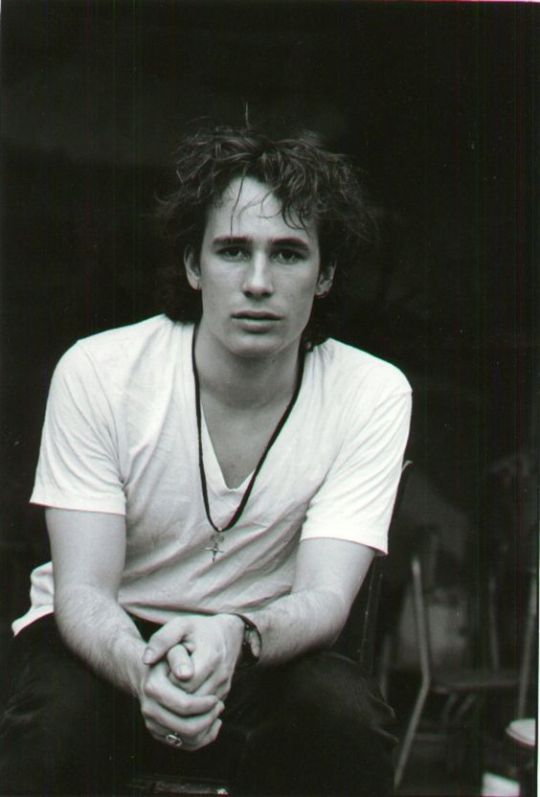
Jeff Buckley
From ’94 to ’96, both solo and with the band, Jeff Buckley toured the world and elsewhere. Those two years were highly transformative; he met and/or was lauded by so many of his personal heroes (including Zeppelin’s Page and Plant, Paul and Linda McCartney, U2’s Bono and The Edge, David Bowie, and he had a brief affair with Elizabeth Fraser of Cocteau Twins and This Mortal Coil, who had covered Tim’s “Song to the Siren” [for aural proof of the romance, go to YouTube and check out their unfinished, embarrassingly smitten PDA duet on “All Flowers in Time”]), picked up an all but unshakeable smoking habit as a late-blooming extension of delayed formative-year rebellion and as a temporary, self-harming relief from the stresses of touring and just-shy-of-A-list fame (he managed to make People magazine’s 50 most beautiful list in May of ’95, which mostly appalled him, and also had an eye-opening night out with Courtney Love), turned down numerous primetime opportunities—SNL, Letterman, and acting roles and commercial placements—in favor of “underground” platforms like MTV’s “120 Minutes,” and was constantly at odds with his record label.
Australia and France embraced him like a returning hero, with the latter country’s Académie Charles Cros presenting Jeff with the rarely-awarded-to-an-American Grand Prix International Du Disque in honor of Grace on April 13, 1995 (two live shows, the second representing a career peak, were recorded during a French leg of the tour and later released as 1995’s Live at the Bataclan EP and 2001’s Live à l’Olympia).
The tank ran dry on March 1, 1996, which marked not only the final date of a hastily booked Australian/New Zealand tour to capitalize on Jeff’s surging popularity there and subsequently the last in official support of Grace, but also the final show with percussionist Matt Johnson, who had reached his hard limit with the band leader’s exacerbated lifestyle excesses and reckless behavior, not to mention Jeff’s escalating hazing of him.
Drummerless and exhausted, a different Jeff Buckley returned to a different New York. Though it suited his dysfunctionally nomadic, reactively noncommittal spirit, touring is not conducive to one’s mental or physical well-being nor is any level of fame, which is unfortunately what moves the units at the cost of anonymous normalcy. As a result, Jeff could no longer frequent any of his old haunts without being recognized and approached by strangers who thought they knew and deserved a piece of him beyond his timeless music. But then even his friends couldn’t help but feel jilted in their wanting a less ephemeral friendship with him, as he made them feel like the undeniably corroborated center of the universe when he was around, having given of himself interpersonally as completely and unadvisedly as he did in his music.
With inchoate fame now cutting him off from his usual decompression options, Jeff couldn’t recharge his psychic batteries. That coupled with the fact that Columbia and the press had been persistently hounding him regarding a follow-up to Grace piled even more pressure on the stress heap, further hampering his creative process and making The Big Apple taste more of the cyanide within the seeds than the once novel fruit of clandestine self-discovery.
There’s an industry saying: a recording artist has their entire life to make the first album and six months to make the second. Already no stranger to writer’s block under normal circumstances (he was inherently a better interpreter than a composer and understandably loath to commit to locked-in versions of anything), Jeff found himself hitting the creative wall in the midst of his increasingly stifling paradigm. The new songs were coming, albeit more slowly than everyone preferred, and in a different, more current vein than Grace. Having kept an ever-vigilant ear to the cultural ground, Jeff had met the Grifters and the Dambuilders while on tour, gaining a new love interest—Joan Wasser, to whom he related early on that he was going to die young—from the latter band and befriended Nathan Larson of Shudder to Think, and their contemporary alternative rock vibes ignited a light bulb over Jeff’s head, giving him the inspiration to pursue a rawer sound, much as Cobain had for Nevermind’s 1993 follow-up—In Utero.
It wasn’t necessarily Sony’s cup of tea. Though the label was by no means dead-set on putting out Son of Grace, they were a bit befuddled by the significant shift in musical mores away from the classic heritage artist sound toward the aural marriage of the Smiths and Soundgarden evident in the newer material. His sagacious selection of classic solo repertoire, and Grace by extension, had gotten Jeff’s foot in the door, as their sophisticated old-school values were arguably a premeditated affectation on Jeff’s part to woo the industry’s boho Boomer gatekeepers into signing and unconditionally supporting him. Now that he was more or less ensconced on the inside, and having gained more than a little leverage from all the hard work of the past year and a half, Jeff wanted to change things up to reflect more of what he’d been listening to and writing as an artist of his own generation. Though jumping high through Jeff’s hoops was by now second nature, Columbia was nevertheless befuddled.
This vexation next manifested as bewilderment over the choice of legendary Television alum Tom Verlaine (RIP) to aid and abet his alt-rock vision as the inexperienced coproducer for the second album. No one at Sony thought Verlaine was the right man for the job; they would just as soon have gone with Andy Wallace again rather than someone who, as with Grondahl, Johnson, and Tighe, didn’t have a track record to speak of. Whether or not Jeff’s choice was ill informed was irrelevant; it became his new crusade against the label, a pyrrhic war waged solely on the principle of getting his way even if it ended up biting him in the ass.
Columbia green-lit some bet-hedging recording with Verlaine to humor Jeff, but also to surreptitiously gather leverage as a failed, debt-enlarging investment, as the odds were slim that he could pull another rabbit out of his hat within the limited, impossible-for-Jeff parameters. Two brief as they were dissatisfying sessions occurred at various New York studios in 1996 and then a third at Memphis’s Easley McCain studios with Johnson’s permanent replacement, Parker Kindred, in early 1997. Jeff had become interested in recording at Easley through Grifters guitarist and Memphis resident Dave Shouse, and in relocating to that hallowed town for its legendary status in the history of blues and rock ‘n roll, and yet also as an escape from the lost anonymity, label pressure, and detrimental distractions of New York.
Jeff began striving for—and was at least able to temporarily reclaim—some semblance of a normal life in Memphis; he settled in at 91 Rembert Street, where he could often be found lying in the overgrown grass of his front yard, staked out all the good local restaurants, got a Sin-é-reminiscent Monday night residency at a downtown venue called Barrister’s, proposed marriage to Joan Wasser, and spent time with local friends who didn’t treat him like a rock star. At the time of his death, and as this evidence indicates, Jeff was trying to settle down, but he also felt ready to finally nail the landing on the second album, which he earnestly hoped would not only eclipse Grace but would frighten people as well. He was also noticeably uneasy.
The iteration of what was going to be called My Sweetheart the Drunk that came out almost too soon in May of 1998, not the barely attainable one Jeff would have overworked himself to complete had he lived, is the version the label should have agreed to put out had he been willing and able to play the long game. Though disc 2, with the exception of “Haven’t You Heard” and the cover of “Satisfied Mind,” is mainly for diehards (it contains sloppily recorded and produced home recordings that only hint at greatness, as well as superfluous original mixes of select disc 1 material), the ten Verlaine tracks are nothing to scoff at. In fact, the minimally but still excellently arranged and produced songs not only sound surprisingly finished, but would have also found Jeff paving the way for the future of alternative rock/pop in a manner that was more in touch with the times but still rang true to Jeff’s old-school tragic-romantic sophistication. Hindsight finds these recordings nothing to be ashamed of, the natural, expectation-managing and yet still promise-fulfilling continuation of Jeff’s artistic journey, though he didn’t—and wouldn’t—agree with that assessment (the tracks probably could have used just a little more tightening up… At the very least, and as it stands, disc 1 of My Sweetheart the Drunk could have been a highly respectable and acceptable “sophomore flop”). Jeff would have had to ease up on the malignant perfectionism had he lived, and in that light it both does and doesn’t seem strange that he continued massaging these recordings—with additional overdubs and polishing occurring at Easley after the band’s return to New York—despite his clearly declared intention to abandon what he had already recorded, concede defeat regarding Verlaine (who urged Jeff to erase the tapes), and start from scratch with Andy Wallace.
Sketches for My Sweetheart the Drunk has plenty of wide-amplitude thrills (“Vancouver,” which started life as an instrumental break on the Grace tour, now featured a soaring vocal that found him suddenly clued in to the detriments of giving too much of himself: “I need to be alone / To heal this bleeding stone…”), lots of tragic-romantic flair (the beautiful, minimally orchestrated ballads “Morning Theft” and “Opened Once,” the swinging caveat “Witches Rave,” and the macabre, “Come as You Are”-ish “Nightmares by the Sea” are by turns self-castigating and wary), more struggle over suitable repertoire (Jeff harbored hypocritical paranoia that the set-apart, slinky R&B slow-jam, “Everybody Here Wants You” would be chosen as a single against his wishes [it was], even though the song is an instant classic, and the album could have done without the cover of the Nymphs’ “Yard of Blonde Girls,” though he didn’t trust Columbia to agree), two Qawwali nods (the mantra jam “New Year’s Prayer”, and the utterly harrowing “You And I”), and plenty of fodder for precognition-of-untimely-death speculators (“Stay with me under these waves tonight / Be free for once in your life tonight…” from “Nightmares By The Sea”, and “Ah, the calm below that poisoned river wild…” from the goosebump-evincing “You And I”).
**************
Recording contracts have always been a Faustian bargain for the artist, especially at the onset, when it is weighted heavily in the card-holding label’s favor. Art and commerce often meet in the cultural-industrial ring as irreconcilable spouses who stay together for the kids, with the artist wanting to make a unique, challenging, and hopefully timeless statement for theirs and successive generations, and the label needing to make a profit, not lose their shirt, or just break even. The latter often requires innocuous music that has been dumbed down or otherwise compromised for mass consumption, usually the antithesis of the former. The artist, though, according to the standard contract they signed, is legally beholden to the label, which owns the master recordings and the right to exploit them until such a time, often years or even decades down the road, when the artist has gained enough cachet through account-balancing sales and accumulated cultural pertinence to renegotiate the contract into a more equitable form that befits their too-hard-earned stature. As with life in general, and back when labels were still labels, one had to play a patient, penitent, somewhat circumspect long game, with eyes intent on the future prize in order to succeed as a recording and touring artist, and to eventually win out over the label.
Bob Dylan and Joni Mitchell, now in or on the cusp of their 80s respectively, managed to successfully undergo and even control their fame-reconciling heritage artist transformations and break through to the other side. Jeff Buckley, who realized too late and too far out to sea that he had given up essential access to a normal life, and whose DNA and hardship-forged personality was geared for fleeting, heightened moments of impulsive escape and unrealistic levels of emotional outpouring during which there was no tomorrow, did not. After an itinerant childhood in a chaotic, single-parent household, neither of which allowed him any bonded, bolstering long-term friendships or gave him the necessary emotional support to instill enough confidence to enable him to pace, self-nurture, and recharge as an adult, Jeff was predestined for burnout. Add to this the looming legacy of his father’s similarly self-inflicted and untimely doom, the demoralizing fiscal and creative debt to—and incongruent association with—a major label, and pervasive generational nihilism, and you have the recipe for a death by misadventure.
The world generally eats pure-heart-on-sleeve empaths like Jeff Buckley for breakfast, and just like house-always-wins Vegas casinos, record labels are particularly good at exploiting, devouring, and then remorselessly shitting out their charges no matter how vigilant the artist may have been to the contrary. In Jeff and Columbia’s case, it’s difficult to pick a winner; dying got him out of both having to deliver on a second album and pay off his way-in-the-red recoupable, but his absence-generated popularity and Sony’s dogged determination to monetize ample vault caches in the aftermath may have balanced the ledger by now anyway. Either way you slice it, and for what it’s worth, the artist is gone, and Columbia is a tawdry shadow of its former self, but Jeff’s timeless music remains.
Trying to imagine how Jeff would have navigated the post-5/29/97 waters is not challenging, considering the comprehensive changes already in motion that would herald not only the end of his generation’s all-too-brief moment in the sun, but also the beginning of the end of the record industry as he had known it. Jeff probably would have seen Sony’s support slowly dwindle, becoming even more isolated until his contract came up for renewal and he was then most likely dropped from the label, as its various employee archetypes, which were industry-wide revolving doors, would have inevitably jumped ship for higher positions elsewhere. This exodus would have severed nurtured—and nurturing—connections, leaving Jeff in the hands of green, bottom-line-focused reps that had had nothing to do with scouting or signing him and were subsequently less inclined to offer the kind of largesse and preferential treatment to which he had been accustomed.
A new generation was also coming of age, one that sought shallower, more effervescent thrills to match their innate, well-nurtured ebullience. Soundgarden, Jeff’s now fellow-in-untimely-death friend Chris Cornell’s band, which was the first of the Seattle grunge era to sign to a major label, broke up almost on cue that year. Groups like Spice Girls, Backstreet Boys, N’Sync, Hanson, and solo artists like Brittney Spears, Ricky Martin, and Christina Aguilera were prepared to replace grunge’s locked-up engine in the zeitgeist car, with already emergent, transitionally mellower sounds from the likes of Dave Matthews Band, Blues Traveler, Phish, Spin Doctors, and Hootie and the Blowfish having paved the way. Autotune was introduced that year, with computer-based digital recording having begun its ascendant journey to becoming the analog-supplanting, music-devaluing standard.
Within a decade, for better and worse, the industry as Jeff knew it would no longer exist, nor would the focus on organically profound music on which he had been brought up and of which he had become a part. With no plan B (he endearingly applied for what would have been a meagerly if at all remunerated position at the Memphis zoo’s butterfly exhibit), Jeff would have been hard-pressed to maintain a subsistent income—let alone pay down his debt to Columbia—inside or outside the new, less tolerant manifestation of the industry, which would have scoffed derisively and dismissively at his to-date album sales. And he probably would have recoiled from the rising popularity of bubblegum pop and nü-metal buffoonery in disgust.
Kurt Cobain once said he wished he had paced himself better, played more of a long game by holding back some of Nevermind’s material for subsequent albums, and a general feeling persists that Jeff had similarly neglected any thought of the future by putting everything he had into Grace, and there wasn’t enough left to create something new to match its grandeur, at least not within his unsustainable paradigm. It seems as though he was done, that his music’s true moment in the sun could only begin after he had disappeared somehow. Amassing cachet would have to rely on his premature-demise-as-career-move absence, the removal of his chronic perfectionism that allowed Sony to put out whatever was in the vaults without his opposition (albeit in full, duly diligent cooperation with next-of-kin trustee, supposed legacy preserver / promoter, and posthumous stage mother Mary), and amassing fin de siècle malaise that would find solace in Grace. But Jeff’s death feels wrong as well, redolent of the same sense of tragedy as JFK’s assassination, as if we had truly lost one of the good ones, and the subsequent sensation of all hope for a fair and just future having been annihilated in a flash, regardless of whether or not either of them actually deserved that idolization.
The grief-sourced application of culpability gets complicated when someone who has deeply affected strangers and loved ones alike is directly responsible for their own death, but it can’t exactly be called a suicide. And though we have plenty of lyrical and anecdotal evidence that could easily be construed as self-fulfilling prophecy (like Cobain, Jeff had consistently and insistently telegraphed his denouement), it is otherwise difficult to substantiate rumors that Jeff had been dreaming of his demise just weeks—if not longer—beforehand. But as with the cinematic portrayal of Mozart obsessively composing what would become his own requiem in Amadeus, if someone persistently gives thought and voice to fatal intent, walks that fine line long enough, the border between this world and the next will begin to blur and smudge until it finally wears thin enough for one to cross over without even noticing. Freud may have said it best: “Until you make the subconscious conscious, it will direct your life, and you will call it fate.”
Unlike influencee Rufus Wainwright, whose songs are also emotive but restrained in comparison, Jeff never developed the necessary filters to mitigate the harmful aspects of his heightened sensitivity and permeability, preferring instead to empty his emotional ballast onstage night after night to the adulation of interchangeable, undemanding strangers (though some of them often clamored annoyingly for renditions of Tim’s songs), as if each show were his last (which he had hypocritically accused Tim of in a 1993 interview). In all of Jeff’s 30 years, he had never learned the kind of self-love that would awaken and bolster the basic long-term survival instincts to enable him to throw off the chains of his deeply ingrained fatalism. With his pallid, fey appearance, alluring gender-balanced charisma, heart-rending empathy, unregulated outflow of emotional energy, and foolhardily unshielded vulnerability, he seemed to many as though he was marked for an early end no matter what evasive action he might’ve taken.
Though Jeff had been exhibiting unstable, borderline bipolar behavior in the weeks prior to his drowning, he didn’t consciously intend to die that night (a nearby witness apparently heard a single cry for help), but his willful ignorance of the dangers of his impulsive and fatalistic nature and the whimsical flouting of the perils of his immediate surroundings would be the co-conspirators of his mortal undoing.
Fully clothed at twilight, Jeff waded backward into a notoriously dangerous river despite a lifetime aversion to water—and in denial of all the overt signals his subconscious and conscious had sent him. Doing the recently learned backstroke to the braggadocio boom-box strains of Zeppelin’s “Whole Lotta Love” in a roiling river all but universally avoided for its severe, passing-boat-generated undercurrents was supposed to be a spontaneous trip to and from the edge to take his mind off of life’s untenable pressures for a short while. But instead, and to his torch-carrying fans’, friends’, and family’s ongoing bereavement, it lasted forever.
**************
England’s annual Meltdown Festival consists of a series of concerts given over several days by contemporary artists and is curated by a celebrity participant with an ear toward the high-minded performance of unconventional repertoire. Jeff was invited by 1995’s chosen Master of Ceremonies—Elvis Costello—to take part on July 1, which serendipitously coincided with that year’s European tour in support of Grace, though it was inconveniently sandwiched between concert dates across the channel.
Along with collaborations in mixed ensembles comprised of co-billed artists, Jeff did a four-song solo set that featured the apropos “Corpus Christi Carol” (the song that had originally piqued Costello’s interest), Nina Simone’s “The Other Woman,” and “Grace.”
He began with an absolutely devastating rendition of “Dido’s Lament,” which Costello had personally requested from the setting of Dido and Aeneas by 16th century British composer Henry Purcell. Jeff was indistinguishable from a fully trained, operatic countertenor as he delivered the moribund lines with innate familiarity:
Thy hand, Belinda, darkness shades me On thy bosom let me rest More I would, but Death invades me Death is now a welcome guest
When I am laid in earth May my wrongs create No trouble in thy breast Remember me, but oh, forget my fate
Costello came out after the last of the four songs and accompanying ovation had died down and following some gracious comments recognizing the young artist’s overflowing docket, he essentially summed up Jeff’s contribution—and the debt of gratitude music owes him—with his closing salutation that now stands as a fitting epitaph:
“He gave everything. Thanks, Jeff.”
#Jeff Buckley Revisited#jeff buckley#jeffbuckley#by Simeon FlickMarch 2023#simeon flick#Remember me#but oh#forget my fate.#––Henry Purcell#“Dido’s Lament”
12 notes
·
View notes
Text
Blog Post #4 Due 2/27
How does online racial construction influence racial and social dynamics offline?
As argued in the text, race and cyberspace are socially constructed phenomena shaped by what is shown and built online. Films like Strange Days, Hackers, Virtuosity, Johnny Mnemonic, and Jumpin’ Jack Flash present black characters as mediators in the real and virtual, supporting the idea and perception that blackness aligns with physicality and street culture. This comes from the way that these films represent Blackness through its “authentic, stable, and ‘real’ ” visual and narrative depictions, influencing offline racial relations to see Blackness this way as well and positioning whiteness as the “default” in cyberspaces (Kolko, 10).
2. What ethical responsibilities should creators of AI and other media creators have in representing race in digital spaces and its usages?
Creators of AI and other media creators should make sure that race is considered in their online designs. Ethically, these creators should take into account that race in online interaction affects social interactions as well. For example, as Prof. Lee talked about in class and at the GSS & WRC Speaker Series about Digital Literacy, AI facial recognition contributes to an environment that ignores systematic inequalities where it incorrectly identifies people with darker skin tones. This lack of knowledge in the creation as well as ignorance becomes detrimental to marginalized communities. Similarly, media creators should examine if their platforms are “race neutral” to avoid this in social interactions.
3. Is there a relationship between today’s American society and video games?
Yes. The phrase “procedural meritocracy” used in the article "Ludo-Orientalism and the Gamification of Race" suggests that there is a relationship since it describes the phrase as a progression system that is dependent on an individual's performance. This shares similarities with video games; for example, advancing through a level requires mastering specific abilities. This phrase also captures the hierarchical structure of modern American society, in which, for example, a student may start kindergarten and would have to pass the grade in order to advance to the next grade level (pg. 5)
4. How is meritocracy illustrated by race?
According to the article “Ludo-Orientalism and the Gamification of Race”, Asian Americans are part of the "model minority" due to their cultural emphasis on academics. They believed that to prove that race doesn’t define one’s ability to compete, they would have to have economic success (pg. 6). Although meritocracy suggests that factors like race, gender, or social status should not determine success, the lack of resources and opportunities means that some individuals face greater challenges in achieving their goals than others, regardless of these factors. The idea that one has to go to school to receive higher education and a high-paying job to prove this success might not be possible for everyone.
3 notes
·
View notes
Text
Big Needs: The Allure of Growing Ladies in Adult Movies
Introduction
In the world of adult movies, there exists a specific niche style that satisfies a particular attraction - big needs. This distinct classification explores the allure of ladies that expand to large proportions, exciting target markets with their imposing presence and commanding visibility. With key words such as "Giantess Porn videos," "Giantess Vore," and "Giantess Development videos" getting popularity, it's clear that this subculture has actually discovered its committed follower base. But exactly what is the charm behind the expanding ladies in grown-up films? Allow's delve deeper into the globe of big needs and discover the factors behind its allure.

Gigantic Needs: The Power of Fantasy Escaping Reality and Unleashing Imagination
One of the main factors behind the appeal of expanding women in grown-up movies lies in their ability to transfer viewers into a world of fantasy. In a globe where restrictions exist, these epic personalities break without societal norms and unleash the creative imagination of their target market. By delighting in fantasies where females broaden to monumental sizes, people can momentarily leave fact and explore their inmost desires without judgment or effect. The aspect of dream offers a feeling of liberation, making it an enticing escape for many.
youtube
youtube
Fulfilling Dominance and Submission Fantasies
Another driving pressure behind the appeal of growing females in adult films is the satisfaction of supremacy and entry dreams. As these giantesses tower above their environments, they exhibit power and control, while concurrently evoking feelings of susceptability in those around them. This power dynamic use primitive impulses, enabling visitors to explore their passive or leading side within a safe and consensual virtual space.
A Visual Spectacle: The Virtuosity Behind Gigantic Desires Cinematic Visual Effects and Specialized Techniques
The appeal prolongs beyond simple narration; it lies in the visual phenomenon that comes with giantess city the growth of these females. Thanks to improvements in modern technology and special effects, grown-up movie producers can produce spectacular scenes where the giantesses tower over their environments, leaving audiences awestruck. The combination of practical visual effects, skilled cinematography, and thorough set layouts all add to the production of an aesthetically exciting experience for the audience.
Creative Storytelling and Narrative Development
While the emphasis might get on the giantesses themselves, the charm of growing ladies in grown-up films likewise comes from the innovative storytelling and narrative growth surrounding their growth. These movies typically incorporate components such as transformation, exploration, and social partnerships to develop a dynamic and engaging storyline. By intertwining compelling narratives with the breathtaking growth sequences, manufacturers have the ability to give a multi-faceted experience that appeals to a wide range of viewers.
Psychological Attraction: Unraveling Desires Microphilia: The Fascination with Miniature Worlds
One emotional aspect that contributes to the charm of growing ladies in grown-up movies is microphilia - an attraction with miniature globes. This fetish facilities around the association of dimension distinctions between people, where a feeling of admiration and question develops from observ

2 notes
·
View notes
Text

PAL-080 Bill Orcutt Guitar Quartet Gatefold 2LP
"Four Guitars Live"
NOTE: Shops & distros worldwide can contact Revolver USA for stock.
As Bill Orcutt’s most mature and exhilarating LP to date, Music for Four Guitars was a slab of undeniable Apollonian beauty. Its approachability and obvious novelty landed it not only on the year- end lists of every key-pushing codger in the underground in 2022, but also on NPR in the form of the Bill Orcutt Guitar Quartet, an ensemble assembled to perform this music and featuring Wendy Eisenberg, Ava Mendoza, and Shane Parish in addition to Orcutt. But while their Tiny Desk Concert gave a whiff of the quartet’s easy intimacy, the sterile confines of the virtual recital medium still left a puzzle unsolved: how might these brutally mannered bricks of minimalist counterpoint sound on a stage in front of actual breathing bodies?
This was the question foremost in my mind when I first saw the quartet in San Francisco a few months before this double live LP was recorded. I was already familiar with the prowess of Eisenberg and Mendoza, two of the most technically intimidating shredders to blast out of the noise/improv underground, and knew Parish as the mastermind behind the epic translation of Orcutt's quartet recordings into a fully notated score. I was ready to be “blown away" — and I most assuredly was. The quartet navigated Orcutt's jaggedly spiraling right angles into the shining core of the compositions with joyous ease, faithful to the originals in nearly every way (though their tempos were slightly ramped up, Blakey style, to communicate their breathless rush). The renditions were flawless, stellar and inspiring. I had expected nothing less.
Which leads us to this album, Four Guitars Live, recorded in November of 2023 at Le Guess Who? festival during the quartet’s first European tour. The true essence of this set is not simply in its faithfulness to the source compositions, but in the group's easy familiarity (no doubt the result of weeks on the road) and the generosity of their improvisations, both collective and solo. Orcutt, clearly cognizant of both the caliber of his collaborators and the
singularity of their voices, has given everyone room to stretch out, and all have delivered some of their most moving passages to date.
One of this record's great thrills for me is imagining a listener, perhaps unfamiliar with the outer limits of contemporary guitar improvisation (or the Tzadik catalog), slammed into catatonia by Mendoza's liquefying lines on Out of the corner of the eye, then revived and healed by the languid, breathy lines of Parish's unaccompanied, spaced-out breakdown of the track's main theme, finally only to be crushed by Eisenberg’s staggering extended solo on Only at dusk (somehow channeling both Eugene Chadbourne and Buck Dharma).
There's another peak, which begins at the end of side B, in Orcutt's own languid solo, encapsulating the flowing focus of his recent solo LPs, and serving as an introduction to the next side's ensemble tour de force, the psychic heart of the album, On the horizon: its melodic core passing first to Orcutt, launching into a sublime solo turn by Eisenberg, a duo of Parish and Mendoza, before parachuting back into the ensemble for a smashup rendition of Barely visible and Glimpsed while driving (renamed Barely driving) knitted together with an softly bubbling ensemble improvisation. The transfer is orchestrated yet seamless, its tonal form undeniable even in the presence of obvious dissonance.
The breadth of Four Guitars Live gives lie to the false notion that agile, polytonal improv is necessarily without soul, is necessarily inaccessible. Rather, Four Guitars posits a human avant-garde music that the most conservative will recognize as virtuosic and revel in its classic intervals, boiling counterpoint, and precisely- layered facets. Even the rockers in your life might dig it, so why not pass it on? — TOM CARTER
6 notes
·
View notes
Text
album game
tagged by @sixtysevenautomatic who had some great choices (especially Full Moon Fever, love that album)
list your 10 favourite albums of all time and tag 10 people to list theirs.
my list, in no particular order:
1. Who’s Next - The Who. Probably my all time favourite album by my all time favourite band. Sometimes spiritual, sometimes ballsy, euphoric classic rock.
2. Revolver - The Beatles. Underrated, in my opinion. Some absolutely banging tracks on this one, with Paul providing absolute fire on bass as usual.
3. Jagged Little Pill - Alanis Morisette. Like virtually everyone my age, this was the album that spoke to my teenage condition and I knew every note.
4. Sheryl Crow - Sheryl Crow. Again, anthemic for teenage me. I listened to this so much I wore it out and had to buy a second copy.
5. Fragile - Yes. Yearning and beautiful. Probably my most listened to prog rock album, so they’ll have to stand in for Pink Floyd, ELP, King Crimson and the rest.
6. Blue - Joni Mitchell. Just one incredible song after another from one of the world’s greatest songwriters. Is it rock, pop, jazz, folk? Who cares.
7. So Much To Say - Take 6. I don’t only listen to rock! Iconic jazz gospel album from a legendary act, never bettered at a capella. Pentatonix wish they were this.
8. Les Miserables original London cast soundtrack. Still one of the best-realised pieces of musical theatre ever, and you can’t beat Colm Wilkinson and Michael Ball imo.
9. Woodstock original festival soundtrack. There’s a reason it’s considered iconic. You can feel the hippie vibes ascending. Jimi Hendrix, Joe Cocker and Richie Havens are probably my favourites.
10. Powerslave - Iron Maiden. I love metal, especially new wave virtuosic heavy metal. Banging album.
It was hard to pick, but I loved doing this. I’m so old that I grew up listening to music in albums as the primary format. I know modern people listen to playlists not albums, so I don’t know how many of you will want to do this, but I’ll tag a few people anyway, and you can play if you want to!
@blacknidstang @brookesallow @mrcowboydeanwinchester @weirdbros @bombingqueen @freakalmond @babybrothershaped @sweetpapercroissant @winchesterride @toedenandbackagain + anyone else who wants to. No pressure if it’s not your thing! Sorry if you’ve already done it and I missed it.
2 notes
·
View notes
Note
hi!! i absolutely love your fics and often find myself going back to them. i wish i could read them again for the first time. i love your writing style, the world building, tk characterization, everything! and i'm deeply attached the most to your mitski-inspired series bec i also love her music and artistry. you're so talented! i hope you're doing well. anyway, i hope this question doesn't come off disrespectful, but will you ever consider writing a tk fic that's based off moonlight (2016) or at least smthg that has its vibes? you're the one i can think of that can nail this perfectly. 😭 thank you!! sending virtual hugs and love your way.
omg this is so sweet and thoughtful of you to say AHHHHH im like rolling around im so happy u connected sm with my work 🥺🥺🥺🥺🥺
as for the moonlight request, i would say honestly that it def inspired the initial tsd feeling, esp tsd1 and 2!!! barry jenkins's eye and storytelling verve is virtuosic and i rmr sitting in the cinema watching moonlight completely overcome with emotion, same with beale street; his depictions of love are just. incredible. operatic and lush and sensual and full of heightened longing and poetry, epic like a field of sunflowers or a lighthouse in a storm. i rmr starting tsd thinking "if i could make a story like barry jenkins does one day i'd die happy" and i still feel like that! idk if i conveyed all the colour and wonder i wanted to (which is probs why it's still unfinished lol sorry!!!) but i was def inspired regardless.
however, in that same vein, i feel conflicted about more directly basing a tk fic on a story that is like... explicitly about the experience of being a Black gay man growing up in the us, and i wouldn't know how to even start to untangle the intensity of those topics. not just bc it's not my personal lived experience, but bc those concepts in concert with each other are the specifics that define its iconic choices that make it one of the best films in history, at least imo. tarell alvin mccraney's play that the movie's based on is inspired by his own life, his commentary on reckoning with his sexuality in the minefield of Black american masculinity and how he personally feels about that, and a lot of the power of the story comes from that, from the specifics his and barry's voices make the story into, ykwim?
anyways, ramble over, i do wanna say thank you again for reading my work and responding with so much love, and maybe the next time u read tsd if u read it with the context of all that love the moonlight gave me (and u from the sound of it!) maybe it'll feel like ur reading it again for the first time 💕
3 notes
·
View notes
Text
Impact Soundworks – Shreddage 3 Argent Download

Are you ready to take your music production to the next level? Impact Soundworks – Shreddage 3 Argent is here to revolutionize your sound with its unparalleled intensity and precision. Designed for metal enthusiasts and producers, this virtual instrument captures the raw power of a 9-string Schecter Damien Platinum guitar, famously used by composer Mick Gordon in the Doom 2016 soundtrack. With over 31,000 pristine 24-bit samples and meticulous attention to detail, Shreddage 3 Argent delivers a level of realism that will leave your listeners in awe.
Why Shreddage 3 Argent Stands Out
Ultra-Low Tuning: Tuned to a crushing low C#, this 9-string beast is perfect for djent, argent metal, and modern progressive genres. Its massive range and virtuosic capabilities make it a versatile tool for any metal producer.
Unmatched Realism: With over 200 hours of sampling, every note, articulation, and dynamic layer has been captured to perfection. From palm mutes to artificial harmonics, every detail is crafted to bring your tracks to life.
Customizable Tone: Recorded through two separate pickup positions (neck and bridge) DI, Shreddage 3 Argent gives you complete control over your sound. Shape your tone to match your vision.
Advanced Articulations: Whether you’re crafting blistering leads or crushing rhythms, Shreddage 3 Argent has you covered. Features include sustains, power chords, slides, tremolo, hammer-ons, pull-offs, and more.
Perfect for Modern Metal Production
Shreddage 3 Argent is not just a virtual instrument—it’s a weapon of sonic destruction. Its 4x down/4x up strokes per note, 3 dynamic layers, and 5 palm mute layers ensure that every performance feels authentic and dynamic. Whether you’re producing djent, progressive metal, or technical death metal, this plugin will elevate your tracks to professional standards.
Get Shreddage 3 Argent Today
Don’t miss your chance to own one of the most powerful virtual guitars on the market. Click the link below to download Impact Soundworks – Shreddage 3 Argent and start creating music that hits harder than ever before.
👉 Download Shreddage 3 Argent Now
#Shreddage3Argent#MetalProduction#VirtualInstruments#MusicProduction#Djent#ImpactSoundworks#ProTools#VSTPlugins#ModernMetal
0 notes
Text

LE060 K. Leimer Slight, Far
Seattle-based composer K. Leimer has been making ambient and experimental music since the mid 1970s, releasing the majority of it on his own Palace of Lights label. Inspired by the tape loop experiments of Brian Eno and the free-form cosmic explorations of krautrock groups such as Cluster and Neu!, he began creating similar sounds at a time when interest in these forms of music was virtually unheard of in the U.S. Leimer’s music began attracting more interest than it ever had during the previous decades when RVNG Intl. issued A Period of Review, a collection of previously unreleased works.
Artist notes: Slight, Far is a self-deterministic, digital, instrumental, approximation of the tape technique used by Anthony Moore in his Pieces from the Cloudland Ballroom. Packets of expanding and contracting phrases occur in a rudimentary phase music setting, further randomised by manually varying the intervals between events so that, unlike Pieces, there is no likely resolution point. To imply distance, the results were then layered into differing depths of an artificial soundstage with the additional goal of intimating the organisational effects of position.
Even as a child I felt that, as incomprehensible as music was to me at the time, it was always too fast; too rushed. Especially lovely sounds—like feedback or the crumpling of an overloaded microphone—were almost always quickly passed over. Like virtuosic playing, an established aesthetic of neatness that attempted to avoid the actuality of the recording medium seemed aimed purely at entertainment and distraction. This sort of experience of music, I thought, ignores and wastes the vast detail, interest, and beauty carried inside every sound.
0 notes